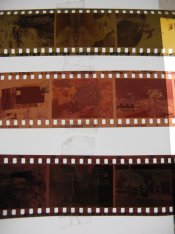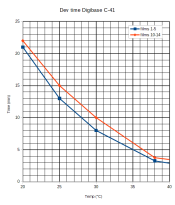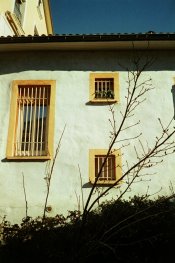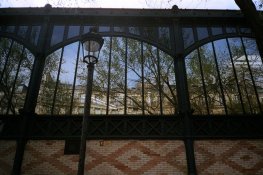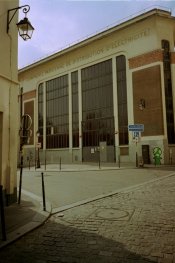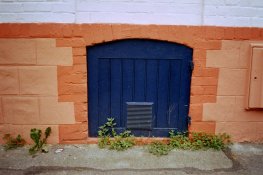bernard_L
Member
- Joined
- Feb 17, 2008
- Messages
- 2,059
- Format
- Multi Format
After reading several users commenting how C41 was easy, I bought a 0.5 litre Compard kit from Maco-direct.
First roll was a "given film" in a "given compact zoom P&S", that I shot to show some appreciation to the donator. Not used to pre-soak, and possibly under stress, I made the mistake to pour the 300cc of Dev into the Paterson tank before pouring out the 300cc of tempering water. Dilution 1+1 in the tank. So I just doubled the dev time at the actual temperature (30°C) . Color images for sure, impossible to be more precise, since the film (Superia 200) had been stored for an unspecified time in unspecified conditions.
At the end of dev, poured Paterson tank (300+300) into a 1 litre brown glass bottle, plus the 200cc that remained in the original Compard 500cc container. So now the initial 500cc of dev is diluted to a total volume of 800cc. Decided I should extend the dev time x1.6.
Colors (after s******g) look OK, but I had no reference, and the film was probably old. Really old.
Second roll. Took some Portra 160 from my fridge. A few shots around the house, plus one of a gray card. Process; Forgot (stress, again) to extend the dev time x1.6. S**n with Vuescan. Black point on film base; white point on gray card, lock manual settings (this means no auto contrast; no auto white balance, etc). Results look fully OK to me.

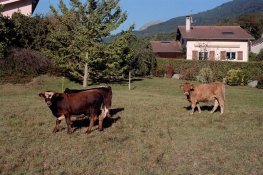

Now, to the point with my question:
Is it appropriate to extend the dev time in proportion to the dilution? I have the impression, from the look of the negatives, that this might be too large a correction. Advice based on actual experience would be welcome. Down-the-nose advice, as "throw out your kit, buy another one, and be more careful next time" is not welcome.
This thread addresses the same issue, but in a milder form: https://www.photrio.com/forum/threads/over-diluted-c-41-rollei.170023/
Maybe David Lyga https://www.photrio.com/forum/threa...to-be-apprised-of-my-c-41-methodology.142128/ would chime in?
I intend to measure the R density (M status) of the gray card image on film #2 and compare with the data at the top of page 3 of https://imaging.kodakalaris.com/sites/prod/files/files/products/e4051_portra_160.pdf; will post results as an update soon.
Third roll, this time with dev time x1.6 is now drying. Left-aside film, no gray card calibration on this one.
First roll was a "given film" in a "given compact zoom P&S", that I shot to show some appreciation to the donator. Not used to pre-soak, and possibly under stress, I made the mistake to pour the 300cc of Dev into the Paterson tank before pouring out the 300cc of tempering water. Dilution 1+1 in the tank. So I just doubled the dev time at the actual temperature (30°C) . Color images for sure, impossible to be more precise, since the film (Superia 200) had been stored for an unspecified time in unspecified conditions.
At the end of dev, poured Paterson tank (300+300) into a 1 litre brown glass bottle, plus the 200cc that remained in the original Compard 500cc container. So now the initial 500cc of dev is diluted to a total volume of 800cc. Decided I should extend the dev time x1.6.
Colors (after s******g) look OK, but I had no reference, and the film was probably old. Really old.
Second roll. Took some Portra 160 from my fridge. A few shots around the house, plus one of a gray card. Process; Forgot (stress, again) to extend the dev time x1.6. S**n with Vuescan. Black point on film base; white point on gray card, lock manual settings (this means no auto contrast; no auto white balance, etc). Results look fully OK to me.



Now, to the point with my question:
Is it appropriate to extend the dev time in proportion to the dilution? I have the impression, from the look of the negatives, that this might be too large a correction. Advice based on actual experience would be welcome. Down-the-nose advice, as "throw out your kit, buy another one, and be more careful next time" is not welcome.
This thread addresses the same issue, but in a milder form: https://www.photrio.com/forum/threads/over-diluted-c-41-rollei.170023/
Maybe David Lyga https://www.photrio.com/forum/threa...to-be-apprised-of-my-c-41-methodology.142128/ would chime in?
I intend to measure the R density (M status) of the gray card image on film #2 and compare with the data at the top of page 3 of https://imaging.kodakalaris.com/sites/prod/files/files/products/e4051_portra_160.pdf; will post results as an update soon.
Third roll, this time with dev time x1.6 is now drying. Left-aside film, no gray card calibration on this one.









